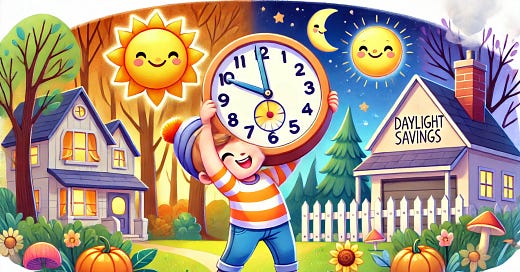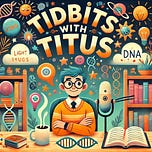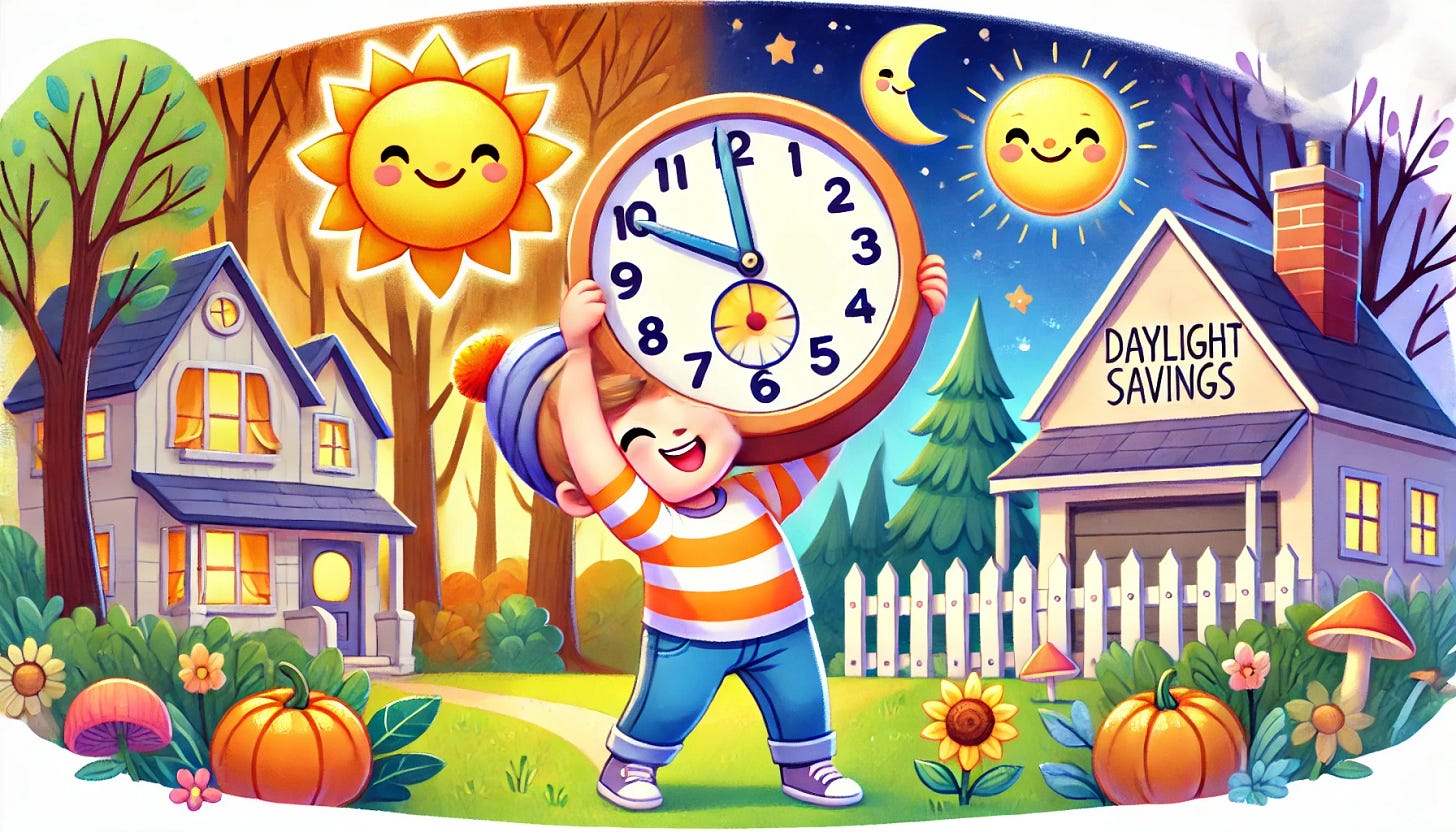What is Daylight Savings Time?
Daylight Savings Time (DST) is when we move our clocks forward by one hour in the spring and move them back by one hour in the fall. This change helps us use the sunlight better during different seasons.
In the spring, we “spring forward” and set our clocks one hour ahead. This means we get more daylight in the evening but lose an hour of sleep that night.
In the fall, we “fall back” and set our clocks one hour behind. This means the sun sets earlier, but we gain an extra hour of sleep that night!
This cycle repeats every year in places that observe Daylight Savings Time. Not every country or state follows it, but many do!
Hello my friends!
For a quick note, welcome to Tidbits with Titus, a podcast and newsletter where we tackle the big, curious questions kids ask every day in fun, bite-sized ways! I’m Alexander Titus, but I go by Titus. I’m a scientist, adventurer, and a huge fan of making science, technology, and life accessible to all ages. From “How does electricity work?” to “What are taxes?” and even “Why is the sky blue?” I’m here to dive into these wonder-filled questions with engaging stories and simple explanations that spark curiosity and make learning a joy. This effort is all about creating a space where families can learn together, discover the magic of the every day, and find thoughtful ways to explore the world’s big mysteries. Let’s make curiosity a family tradition—one tidbit at a time!
Just so you know, these podcast episodes are all AI-generated using Google’s really cool NotebookLM technology. That means there are some errors in how words are said, but that is part of the fun!
If your little ones have questions that you want help answering, shoot me an email at questions@tidbitswithtitus.com and I’ll see what I can do!
You can subscribe to the newsletter that has this information as well at tidbitswithtitus.com.
Also please share with anyone you think would be interested. The more the merrier!
Cheers,
-Titus
Why Do We Have Daylight Savings Time?
A long time ago, people didn’t have electric lights like we do now. They depended on the sunlight to do their work. As the seasons changed, the amount of daylight they had during the day also changed. To make better use of daylight, people came up with the idea of shifting the clocks so they could have more sunlight in the evening.
One of the first people to suggest this idea was Benjamin Franklin. In 1784, he wrote about how changing the clocks could help people save candles because they wouldn't need to burn them in the evenings as much.
Later, during World War I and World War II, some countries started using Daylight Savings Time to save energy. They thought that if people used more sunlight, they wouldn’t have to turn on as many lights or use as much electricity. Today, some places still use DST, but others have stopped because modern electricity use is different from the past.
How Does Daylight Savings Time Affect Us?
When we change the clocks, it can affect our daily lives in many ways. Here are some things that happen:
More Sunlight in the Evening: When we move the clocks forward in the spring, the sun stays out later in the evening. This means kids can play outside longer, and families can do fun activities after work and school.
Darker Mornings: When we “spring forward,” the mornings can be a little darker for a while. It might still be dark when you wake up for school!
Sleep Changes: When we change the clocks, our bodies need time to adjust. Some people feel extra tired for a few days because their sleep schedule is a little off.
Helps Businesses: Some stores and businesses like Daylight Savings Time because when it stays light outside longer, more people like to go shopping or eat at restaurants after work.
Who Uses Daylight Savings Time?
Not all places in the world use Daylight Savings Time. Here are some examples:
Countries that use it: The United States (except for some states like Hawaii and most of Arizona), Canada, the United Kingdom, and parts of Australia.
Countries that don’t use it: Many countries near the equator, like Ecuador and Indonesia, don’t need DST because their days and nights stay about the same length all year round.
Fun Facts About Daylight Savings Time
The idea of Daylight Savings was first introduced in 1784 by Benjamin Franklin, but it didn’t become widely used until World War I.
Not all U.S. states follow DST. Hawaii and most of Arizona do not change their clocks.
Some animals, like farm animals, get confused by the time change because they are used to being fed at the same time every day!
The European Union has been thinking about stopping Daylight Savings Time. Some people like it, while others think it isn’t needed anymore.
Should We Keep Daylight Savings Time?
Some people think Daylight Savings Time is great because it gives us more sunlight in the evening. Others think it’s not necessary anymore and can make sleep schedules harder for people.
Arguments for keeping DST:
More daylight in the evening means more time for outdoor activities.
Some businesses benefit because people shop more when it's light outside.
Some studies say it can help lower crime rates since there’s more daylight.
Arguments for stopping DST:
Changing the clocks can make people tired and mess up their sleep.
Not all places need it, and some areas want to stay on the same time all year.
Some experts say it doesn’t save as much energy as it used to.
How Can You Adjust to the Time Change?
If you live in a place that follows Daylight Savings Time, here are some tips to help adjust to the time change:
Go to bed a little earlier a few days before the clocks change.
Get plenty of sunlight during the day to help your body adjust.
Avoid screens (like tablets and TVs) right before bed to help you sleep better.
Eat healthy foods and stay active to keep your energy levels up!
Conclusion
Daylight Savings Time is a way to make better use of sunlight by changing our clocks twice a year. It started as a way to save energy, but today, people have different opinions about whether we should keep it or not. Some places still follow it, while others have stopped.
No matter what, it’s always good to understand how time changes affect our daily lives. The next time your family changes the clocks, you can tell them all about why Daylight Savings Time exists and how it started. Now, what do you think—should we keep Daylight Savings Time or get rid of it? Let’s talk about it!













Share this post